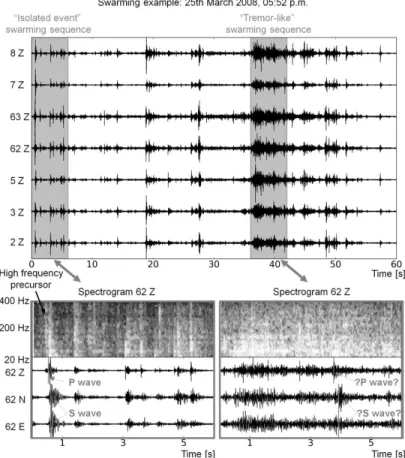HAL Id: ineris-01862560
https://hal-ineris.archives-ouvertes.fr/ineris-01862560
Submitted on 27 Aug 2018HAL is a multi-disciplinary open access archive for the deposit and dissemination of sci-entific research documents, whether they are pub-lished or not. The documents may come from teaching and research institutions in France or abroad, or from public or private research centers.
L’archive ouverte pluridisciplinaire HAL, est destinée au dépôt et à la diffusion de documents scientifiques de niveau recherche, publiés ou non, émanant des établissements d’enseignement et de recherche français ou étrangers, des laboratoires publics ou privés.
Interpreting microseismicity induced by a collapsing
solution mining cavity
Jannes Kinscher, Isabelle Contrucci, Pascal Bernard, S. Cesca, Anne
Mangeney, Jack-Pierre Piguet, Pascal Bigarre
To cite this version:
Jannes Kinscher, Isabelle Contrucci, Pascal Bernard, S. Cesca, Anne Mangeney, et al.. Interpret-ing microseismicity induced by a collapsInterpret-ing solution minInterpret-ing cavity. French-Japanese symposium an earthquakes & triggered hazards, Sep 2015, Orléans, France. pp.66-68. �ineris-01862560�
Interpreting microseismicity induced by a collapsing solution
mining cavity
J.L. Kinscher (1), I. Contrucci (1), P., Bernard (2), S. Cesca (4), A., Mangeney (2,3),
J.P., Piguet (5) and P., Bigarre, P. (1)
(1) L’Institut National de l’Environnement Industriel et des Risques INERIS, Nancy, France. E-mail: Jannes-L.KINSCHER@ineris.fr, Tel. +33 3 55 66 28 81
(2) Institut de Physique du Globe de Paris IPGP, Sorbonne Paris Cité, UMR 7154 CNRS, Paris, France
(3) University Paris Diderot, Paris and ANGE Team, INRIA, CETMEF, J.-Louis Lions, Paris, France
(4) GFZ German Research Centre for Geosciences, Potsdam, Germany
(5) Université de Lorraine, GeoRessources lab.,campus Artem, Nancy, F54042, France
In order to improve our understanding of hazardous underground cavities, the development and collapse of a ~200 m wide solution mining cavity was seismically monitored at a SOLVAY exploitation site at Cerville-Buissoncourt in the Lorraine basin, NE France (e.g. Kinscher et al. 2015). The recorded microseismic data set (~ 50.000 event files) represents two major microseismic crises, (i) one recorded in March to April 2008, related to a period of significant cavity roof gowth (without subsequent surface collapse), and (ii) one crisis in February 2009, associated with a 3 days lasting collapsing period, induced by controlled brine pumping operations. The numerous microseismic events (~ 50.000 event files) appeared as unusual swarming sequences with complex clusters of superimposed microseismic events (Fig. 1). Consequently, only a minor portion (~20%) of the data set could be processed through standard body wave phase based detection, location and source analysis routines.
In this study, we present innovative methods able to generate a complete seismic catalogue of this unique microseismic data. First, a probabilistic, automatic detection location design has been developed that constrain the spatio-temporal characteristics of microseismic swarms in a first order (Kinscher et al. 2015). In this approach, mainly signal polarization attributes were used to identify P wave phases. Event locations were then obtained by using the information of the corresponding polarization angles, as well as signal amplitudes and a calibrated attenuation law describing the amplitude decay with distance. Moreover, seismic source mechanisms and standard source parameters were investigated by comparing observed and synthetic wave forms, amplitude spectra and peak-to-peak amplitude ratios, assuming different standard source models. Within this source study, it was possible to assess the common source mechanisms of many swarming events at once, using the observation from only one single three component station.
The main results obtained by these developed methods, as well as by detailed statistical analysis of the spatio-temporal and energetic microseismic attributes are as follows: (i) the individual microseismic events are comparable to small natural tectonic earthquakes with moment magnitudes Mw ranging from around −3 to 1;
(ii) source mechanisms for most microseismic events are remarkable stable and demonstrate a predominant thrust faulting (double-couple) regime with faults similarly
oriented NW-SE, dipping 35° − 55° , what might be related to the presence of systematically arranged pre-existing fractures;
(iii) the origin of microseismic swarming is suggested in the incapacity to sustain larger strains and to release larger stresses, what seems to be related to the mechanical constitution of the rock strata overlying the cavity (i.e. low strength materials);
(iv) caving and collapsing periods at the cavity roof are associated with systematic, self- reinforcing dynamics and have a distinct microseismic response, clearly observable from statistical analysis, which can be precisely described by empirical laws.
These results underline that microseismic monitoring and the here developed methods are a powerful tool to constrain the mechanical and dynamical characteristics of an evolving and collapsing hazardous underground cavity. In addition, our results provide new important constraints for the design of adequate geomechanical models that will improve hazard assessment at underground openings.
Figure 1: Example of a typical swarming sequence. Figure is taken from Kinscher et al.
(2015).
Kinscher, J., Bernard, P., Contrucci, I., Mangeney, A., Piguet, J.P., and Bigarre, P. (2015). Location of microseismic swarms induced by salt solution mining. Geophysical Journal International. 200, 337-362.
